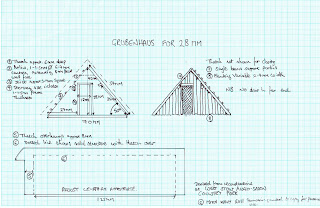Roughly contemporary with the Grubenhaus are the Pictish wheelhouse and figure of eight house, so these are obvious choices if you need battlefield buildings for fights in "points North" of the British Isles during the Dark Ages. I've tried to come up with a quick, simple design, like the Anglo-Saxon structures I've done previously.
The wheelhouse is the simplest, but may not, for reasons given below, float everyone's boat. Despite this, hopefully it's sufficiently visually distinct from a Grubenhaus, or indeed the more square / rectangular Saxon structures.
A wonderful, very complete resource for buildings that might be useful for Pictish wargaming purposes is Professor D.W. Harding's "
The Hebridean Iron Age: Twenty Years' Research". This work, freely available on the web, is full of information and packed with fantastic ground plans of buildings that show the size, shape and general layout of everything from relatively small wheelhouses up to and including full-sized brochs. For anyone with access to a good library, or willing to spend a significant amount of money, I would also recommend
this without hesitation.
As an aside, brochs are generally large structures, having diameters from about 9-10m upwards (180-odd mm in 1/56th scale) and correspondingly tall. Whilst a broch would make a breathtaking centrepiece for a Dark Ages wargame, it's a bit big as a minor feature to add a dash of colour or interest. For now, I'm leaving brochs alone and concentrating on things rather smaller, quicker and simpler.
The wheelhouse is so described because the internal structure, with the stone internal walls rising to provide a corbelled base for the timber roof, resembles a spoked wheel. For the sort of simple modelling purposes I'm going to describe, the internal structure is irrelevant, because it won't be there to be seen!
The three major characteristics of the wheelhouse are:
1 Drystone walls, of very significant thickness. The walls are frequently the best part of a metre thick, sometimes double-skinned with a rubble core.
2 A relatively shallow pitch to the roof, especially as compared with roundhouses in parts of southern England. This might be of turf, as attributed in this
reconstruction in the Shetland Islands (see
here also for further details), or heather thatch secured with weighted ropes as used into recent times.
3 Sunken into the ground. For whatever reason (security, ease, resistance to strong winds or whatever), wheelhouses are often set into an excavated pit, with only a small part of the wall structure visible. This is the caveat I mentioned above about visual appeal. Being half-buried, it isn't exactly a striking structure!
I based this model on the reconstruction above, with some details drawn from Professor Harding's work. The Shetland reconstruction has a roof angle of about 18 degrees. From this, the magic of trigonometry provides a vertical height for the centre of the roof! Being basically a cylinder with a slight point on it, there's no point in drawing a complicated plan.
A block of packing foam is cut to form a suitable cylinder, and marked up for the distance from the eaves to the apexs. The cocktail stick makes a nice, obvious marker for the centre point that can't get lost too easily.
Cylinder, with height and centre marked
The waste was trimmed away carefully - you want to keep this nice and symmetrical, if you can, and a doorway was cut in.
Roof shaped and doorway added
Walling allows many choices. If you make the thing out of close-cell foam, you can engrave the stone pattern with a pencil. On this cheap stuff I use, you need to add something over the top. One alternative is decorator's filler or tile cement, spread on and then engraved whilst wet. Quicker, but a bit more expensive is to use random stone pattern plastic card. "More expensive" is very relative - one sheet of Slater's random or coursed stone costs under £2 and will make about half a dozen houses like this, so it still isn't very dear.
I've used Slater's 2mm coursed stone sheet, which looks fine to me. I've folded back the plastic card in the door entrance to give the impression of the stone going through the building, and added a lintel from plastic card.
I fitted the door at this stage - it's easier, when there's still decent access. Now let the whole thing dry totally. You don't want to pull the wall surface off during the next stage!
Based, with door and revetting installed
Find a suitable bit of foam for a base, and cut out a hole to take the hut. Glue the base to a sheet of (e.g.) MDF, then install the hut into the hole. Trim and shape the base to give the impression that it's rough ground, and cut a slot to represent the path down to the subterranean doorway. Don't make this too steep.
Alternatively, make it look like it's paved, in steps. The sides of the slot can have stonework added to give the impression of revetting.
Top view
The roof, being turf, is left till last with the rest of the basework. This is PVA, sharp sand and flock - lovely! The little bits of Green Stuff either side of the door are to smooth in where the plastic card doesn't quite lap over and I had to put an extra piece in.
Basic groundwork complete
Painted up, with various grey and brown drybrushings over a base coat of panzer grey on the stone / woodwork, it looks OK to me. The Pictish ne'er-do-well posing for scale effect is from Black Tree Designs. Wonderful figures, but don't mention the customer service...
A Pictish des res!
Enjoy!









































